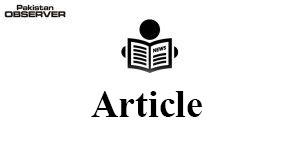U K Dar
NATIONS will always go to war, especially if negotiations yield no outcome, over issues that are strategically and economically important to them. This holds truer for nations that are eyeing to be superpowers of the next century. Assumptions are dangerous. Assumptions that nuclear armed neighbors would not go to war could be hazardous. China and India have involved in skirmishes across Line of Actual Control (LAC) since last month causing significant loss of men and material; any miscalculation could result into a full fledged war that could end with a nuclear strike, a possibility that cannot be ruled out. The assumption of Nehru that China would not go to war with India in 1962 had been proven wrong which caused him and India a humiliating defeat. The stakes are very high as compared to 1962, both regionally and in terms of global power balances. Neither China nor India had nuclear weapons then. The world is no longer an unipolar and USA has lost its power and credibility and hence can have minimal influence on either of the countries for diffusing the situation.
The present crisis unfolding in Gulwaan Valley looks like action replay of 1962 events. Then India after acquiring aircraft, helicopters, engineering and other military equipment from USA and Russia invaded Portugese Goa in December 1961. Goa was constitutionally incorporated into Indian Republic. Next year in early months of 1962, the Home Minister of India threatened that if the Chinese will not vacate the Indian [disputed] areas, India will repeat what she did in Goa. China offered India to mutually withdraw their armed force 20 KM from the disputed LAC but India ignored it. In July 1962, a Gurkha platoon was sent forward to cut off Chinese outpost in Galwan Valley. Immediately, a Chinese battalion surrounded the Indian post, cutting it off from supplies and routing the Indian platoon. This border skirmish then led to a full fledge war and the outcome was a humiliating defeat to Indian Army.
Many critics consider that the ‘opportunity’ of Sino-Indian war gave Pakistan a vital chance to resolve the long outstanding Kashmir issue and argued that Pakistan should have attacked Kashmir while India was engaged in conflict with China. However, President Ayub was given a clear message from US and the UK that they would view a Pakistani move against India as a hostile and aggressive action inconsistent with the SEATO and CENTO treaties. Iran’s Shah rather advised Pakistan to send his soldiers to fight alongside Indian soldiers to curtail the Chinese red menace. As the war began, President Ayub decided to remain neutral, a folly in many views. Pakistan’s magnanimity of not attacking India when she was at its weakest, however, could not please India. Rather, to divert the internal political turmoil and public criticism, India found an easy way out and on a pretext of insurgent movement getting momentum in India-occupied Kashmir, attacked Pakistan in 1965. Before taking this action, India spent fortune and modernize and expand the capacity of its armed forces.
Fast forward to 5 August 2019, the Narendra Modi government revoked Article 370 unilaterally, which had guaranteed a special status to the former disputed territory of Jammu and Kashmir State, including the areas of Ladakh region. India merged those areas unconstitutionally with the Indian union. Changing the status of Ladakh region irked China as the region is crucial for her access to Central Asia and CPEC project. CPEC passes through Karakoram, close to Galwan Valley, and can be used to cut off the CPEC route. CPEC is a major cornerstone of China’s strategic planning as it ensures her direct access to warm waters through Arabian Sea. Furthermore, another red flag was raised when a day after abrogation of Article 370, Indian Home Minister said that India will get back not only AJK but also the 38,000 sq km of Aksai Chin Plateau that has been under Chinese occupation since 1962. Thus, China and Pakistan, strongly denounced the move at the UN Security Council last year; which as usual did nothing concrete other than issuing a statement asking all sides to “refrain from taking any unilateral action which might further aggravate” an already “tense and very dangerous” situation.
India underestimating the Chinese resolve tried to occupy Galwan Valley but was given a bloody nose. If history could be our guide, it seems more than likely that India cannot face the might of Chinese military and will not try to further the clash across LAC. However, to divert the attention of Indian public from the utter humiliation that Narendra Modi government had faced and to win hearts of Hindu nation, a border skirmish with Pakistan cannot be ruled out. Recent menacing military build-up, publicizing its casualties in clashes with freedom fighters and enhanced cross border firing can be seen in the same context. Pakistan military leadership is alive to the situation and unprecedented meeting of the top military leadership in recent days is reassuring and should be seen as part of the military’s strategic signalling to India. Nonetheless, no war can be fought without the public support and it is high time that political bickering amongst the political leadership be curtailed to tell the world in general and India in particular that Pakistan is alive to the situation and any misadventure by them would result in full-fledged response from our military, like was given to the intruding jets, and that no solution of Kashmir is acceptable to Pakistan outside the UN Security Council resolutions.
—The writer is freelance writer based in Manchester, UK.










